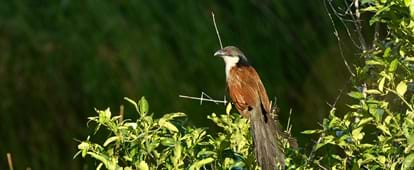By creating an account, I agree to the
Terms of service and Privacy policy
Choose your country and language:
Africa
Americas
Asia Pacific
Europe
BBirding in South Africa is simply spectacular at Nylsvley Nature Reserve, which protects a significant portion of the country’s largest inland floodplain – totalling 16 000 hectares when water levels are highest during summer. This 16 000-hectare floodplain, which floods every three to four years, has been registered as a RAMSAR site due to the importance it has for water fowl in South Africa.
Up to 80 000 birds can be found at Nylsvley at one time and it is the largest Cape Vulture breeding colony in the country. This area is the only place in the Limpopo province where you can see the rare yellow-throated Sandgrouse, as well as the Blue Crane, Barrow's Korhaan and Stanley's Bustards, while enjoying vast wide open spaces and spectacular scenery. The area has the added attraction of being close to Gauteng and the O.R. Tambo International Airport, and it is in a Malaria-free part of the province.

SSouth Africa's seven biomes are home to over 850 bird species, many of them endemic. Unsurprisingly, the country is a popular birding destination and also has a relatively large local birding community.
Nylsvley Nature Reserve, Limpopo
NNylsvley Nature Reserve in Limpopo is a 4 000-hectare reserve that has around 370 bird species, including rare ones like the dwarf bittern and rufous-bellied heron. Of the 365 bird species recorded in the Nylsvley area, 104 are water birds and, of those, 87 breed here in the wet years. Special breeds to look out for include Little Dwarf and Eurasian Bittern, 15 species of duck and geese, Allen's Gallinule, Lesser Moorhen as well as seven species of Crake and Rail, to mention a few.
The surrounding area makes birding at Nylsvley extra interesting. The acacia thornveld is home to many dry-country species, which form an eclectic mix of birds that can also be found in the western Kalahari region and the eastern savannah region of the Kruger National Park. Besides the waterbirds, the bushveld surrounding Nylsvley also offers great birding, with eight species of owls being recorded and a chance of seeing the spectacular Orange-breasted Bush Shrike and Crimson-breasted Shrike amongst the 200 other bushveld species found here.
Related articles

